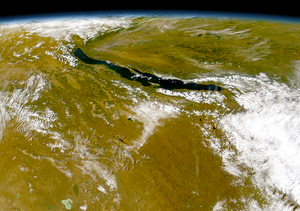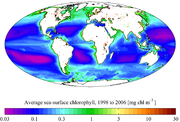
SeaWiFS
Encyclopedia


Field of view
The field of view is the extent of the observable world that is seen at any given moment....
Sensor. It was the only scientific instrument
Measuring instrument
In the physical sciences, quality assurance, and engineering, measurement is the activity of obtaining and comparing physical quantities of real-world objects and events. Established standard objects and events are used as units, and the process of measurement gives a number relating the item...
on GeoEye
GeoEye
GeoEye Inc. is a commercial satellite imagery company based in Herndon, Virginia that is the world's largest space imaging corporation....
's OrbView-2 (AKA SeaStar) satellite
Satellite
In the context of spaceflight, a satellite is an object which has been placed into orbit by human endeavour. Such objects are sometimes called artificial satellites to distinguish them from natural satellites such as the Moon....
, and was a follow-on experiment to the Coastal Zone Color Scanner
Coastal Zone Color Scanner
The Coastal Zone Color Scanner was a multi-channel scanning radiometer aboard the Nimbus 7 satellite. Nimbus 7 was launched 24 October 1978, and CZCS became operational on 2 November 1978. It was only designed to operate for one year , but in fact remained in service until 22 June 1986...
on Nimbus 7
Nimbus program
The Nimbus satellites were second-generation U.S. robotic spacecraft used for meteorological research and development. The spacecraft were designed to serve as stabilized, Earth-oriented platforms for the testing of advanced systems to sense and collect atmospheric science data...
. Launched August 1, 1997 on an Orbital Sciences Pegasus small air-launched rocket
Rocket
A rocket is a missile, spacecraft, aircraft or other vehicle which obtains thrust from a rocket engine. In all rockets, the exhaust is formed entirely from propellants carried within the rocket before use. Rocket engines work by action and reaction...
, SeaWiFS began scientific operations on 18 September 1997 and stopped collecting data on 11 December 2010. The sensor resolution is 1.1 km (LAC), 4.5 km (GAC). The sensor recorded information in the following optical bands:
| Band | Wavelength |
|---|---|
| 1 | 402-422 nm Nanometre A nanometre is a unit of length in the metric system, equal to one billionth of a metre. The name combines the SI prefix nano- with the parent unit name metre .The nanometre is often used to express dimensions on the atomic scale: the diameter... |
| 2 | 433-453 nm Nanometre A nanometre is a unit of length in the metric system, equal to one billionth of a metre. The name combines the SI prefix nano- with the parent unit name metre .The nanometre is often used to express dimensions on the atomic scale: the diameter... |
| 3 | 480-500 nm Nanometre A nanometre is a unit of length in the metric system, equal to one billionth of a metre. The name combines the SI prefix nano- with the parent unit name metre .The nanometre is often used to express dimensions on the atomic scale: the diameter... |
| 4 | 500-520 nm Nanometre A nanometre is a unit of length in the metric system, equal to one billionth of a metre. The name combines the SI prefix nano- with the parent unit name metre .The nanometre is often used to express dimensions on the atomic scale: the diameter... |
| 5 | 545-565 nm Nanometre A nanometre is a unit of length in the metric system, equal to one billionth of a metre. The name combines the SI prefix nano- with the parent unit name metre .The nanometre is often used to express dimensions on the atomic scale: the diameter... |
| 6 | 660-680 nm Nanometre A nanometre is a unit of length in the metric system, equal to one billionth of a metre. The name combines the SI prefix nano- with the parent unit name metre .The nanometre is often used to express dimensions on the atomic scale: the diameter... |
| 7 | 745-785 nm Nanometre A nanometre is a unit of length in the metric system, equal to one billionth of a metre. The name combines the SI prefix nano- with the parent unit name metre .The nanometre is often used to express dimensions on the atomic scale: the diameter... |
| 8 | 845-885 nm Nanometre A nanometre is a unit of length in the metric system, equal to one billionth of a metre. The name combines the SI prefix nano- with the parent unit name metre .The nanometre is often used to express dimensions on the atomic scale: the diameter... |
The instrument was specifically designed to monitor ocean characteristics such as chlorophyll
Chlorophyll
Chlorophyll is a green pigment found in almost all plants, algae, and cyanobacteria. Its name is derived from the Greek words χλωρος, chloros and φύλλον, phyllon . Chlorophyll is an extremely important biomolecule, critical in photosynthesis, which allows plants to obtain energy from light...
-a concentration and water clarity.
It was able to tilt up to 20 degrees to avoid sunlight from the sea surface. This feature is important at equatorial latitudes where glint from sunlight often obscures water colour. SeaWiFS had used the Marine Optical Buoy for vicarious calibration.
The SeaWiFS Mission is an industry/government partnership, with NASA
NASA
The National Aeronautics and Space Administration is the agency of the United States government that is responsible for the nation's civilian space program and for aeronautics and aerospace research...
's Ocean Biology Processing Group at Goddard Space Flight Center
Goddard Space Flight Center
The Goddard Space Flight Center is a major NASA space research laboratory established on May 1, 1959 as NASA's first space flight center. GSFC employs approximately 10,000 civil servants and contractors, and is located approximately northeast of Washington, D.C. in Greenbelt, Maryland, USA. GSFC,...
having responsibility for the data collection, processing, calibration, validation, archive and distribution. The current SeaWiFS Project manager is Gene Carl Feldman
Gene Carl Feldman
Gene Carl Feldman has been an oceanographer at NASA / Goddard Space Flight Center since 1985. His primary interest has been to try and make the data that NASA gathers from its spaceborne fleet of Earth observing instruments, especially those monitoring the subtle changes in ocean color, as...
.

